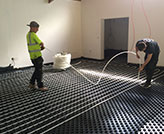The cosy feeling underfoot in the morning is pure bliss. Underfloor heating gives you that luxurious vibe while being an energy-smart way to keep your place heated. But have you ever stopped to think about how is underfloor heating installed?
Our installers have to start by clearing out the floor area completely. For new construction, that’s easy – they just work with the subfloor and existing plumbing stubs. But in a renovation, that might involve ripping up old floors, and floor coverings like tile or wood, and dealing with the existing plumbing and electrical systems.
Once the area is prepared, they put down a layer of insulation panels directly over the subfloor. These foam boards help increase the system’s efficiency by preventing heat loss downwards. Our installers then lay down a coat of concrete-based sealant over the insulation. This provides a nice even base to work on.
From here, the installation differs slightly between electric cables and hydronic tubing. But the main goal’s the same – laying out the heating elements in a pattern for even warmth distribution.
For electric systems, they use insulated conductive polymer cables in a pre-planned pattern, secured with cable ties. They run aluminium tracks across the floor, securing them to hold cables/tubing firmly.
Next is pouring lightweight concrete/gypcrete over everything to cover the system and provide thermal mass.
For electricity, they run a cold lead conduit from cables to the thermostat/breaker area to connect to the electrical.
Hydronic systems need a whole feed/return tubing network from floor loops to the boiler/water heater. Tubing joints get leak tested and secured before the concrete pour.
Depending on the system, they might install other components like manifolds, valves and pumps in the mechanical room too. Once all lines are run, they enclose the floor area with temp framing for the concrete pour.
They work the wet gypcrete and let it cure. After curing, final floor coverings like tile, wood or carpet go over the heating layer, sometimes with a thin underlayment.
With coverings down, it’s wiring time. For electricity, they connect the cold lead to a GFCI breaker and thermostat. For hydronic, they connect the tubing loops to the boiler/water heater and controls.
Now you know how is underfloor heating installed. Underfloor heating systems demand quite a process to install correctly, that’s for sure. But the payoff is an ultra-comfortable, efficient, and luxurious heating setup that makes frigid mornings much easier to face. Plus, warm toes are just plain nice to experience daily.








